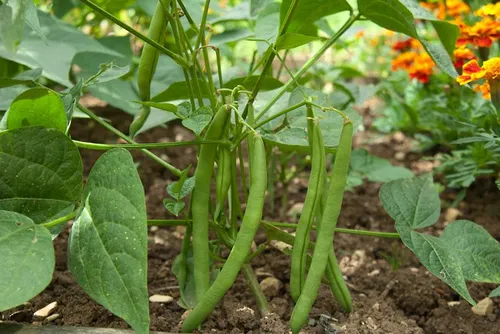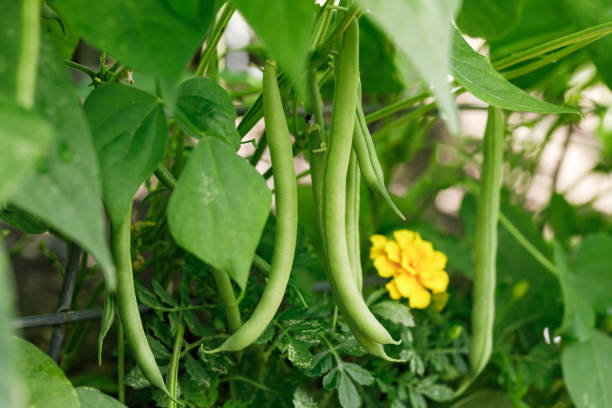FRENCH BEANS PRODUCTION
French beans, locally called Mushiri is a major export crop. Its interest has rapidly increased both for fresh consumption and for processing through canning and freezing. Thy can be grown both on large scale and small scale though it requires many management systems and it is labour intensive. It takes 45-50 days to mature, making them a crop for farmers seeking short production. With proper irrigation, they are grown throughout the year.
Ecological requirements to grow French Beans
Soil
French beans require well-drained loam soils to heavy clay soils have high organic matter content. The optimal pH is 6.5 to 7.5 but they can tolerate a lower pH up to 4.5
Rainfall
If relying on rain to grow French beans, well-distributed rainfall of 900-1200mm per annum is required.
Altitude
French beans grow well at an altitude between 1000 - 2100m above sea level.
Temperature
French beans grow well at the optimum temperature ranges of 20 to 25 degrees Celsius. They can grow in temperatures of between 14 to 32 degrees Celsius, but extreme temperatures lead to poor flower development and fruit set. They mature earlier in warmer areas. French Beans should not be grown on the same plot twice without being intercropped or practicing crop rotation. This is because crop rotation when growing French beans helps in controlling weeds, soil erosion, reduces pest population, diseases, and rejuvenates the organic matter in soil.
LAND PREPARATION AND PLANTING
French Beans are sown directly into the seedbed. Seed Rate: 20–25 kg per acre. Planting should be scheduled as peak seasons are October to December and from mid-January to end of May. Also continuous production and ensure proper management as to maintain
In warm areas, beans take 45 to 50 days from planting. First picking done August -October, then plant again early in December. Planting should be in Single rows 30 X 15cm (1 seed per hole) or double rows 60 X 30 X 10 cm is used. The plant population is 88,888 per acre. It is advisable to plant in blocks of four single rows separated by a path of about 50 cm for ease of management practice.
WATER MANAGEMENT
A regular water supply is essential as moisture affects yields, uniformity and quality. Water stress during flowering causes flower abortion and thus reduces yields. It is advisable to grow the beans on ridges while using furrow irrigation in heavy clays since beans are very sensitive to water logging.
WEEDING
Timely and thorough weeding is essential. The first weeding should be done 2 – 3 weeks after emergence followed by a second weeding 2 – 3 weeks later. Care should be taken to avoid damaging the shallow roots especially during the first weeding. Never weed the crop when it is at flowering time and/or when the field is wet to avoid flower shedding, spread of diseases and soil compaction
PEST AND DISEASES
The main diseases in French beans farming include aphids, red spider mites rust, angular leaf spot, root rots, bacterial blights, cutworms, beetles, and caterpillars, bean common mosaic virus, powdery mildew and downy mildew. To control these diseases, farmers are advised to use crop rotation, tolerant varieties, field hygiene, health certified seeds, and recommended insecticides and fungicides.
HARVESTING
French beans are harvested before the pods are fully-grown. They should be harvested early in the morning when it is cool since the pod temperature is low. Picking of pods should begin 6 to 8 weeks after sowing. In addition, it should continue up to 2 months depending on the variety and ecological conditions on the area. Care should be taken when picking not to pull from the plant, and should have the stalk attached to them.

Picking should be done at regular intervals, and depending on the buyer specification. Harvesting should be done at least twice a week for the fine beans and three times a week for the extra fine beans. Young French beans are tasty when harvesting it encourages more production.
POST HARVEST PRACTICES
Harvested beans should be kept in a cool shaded and ventilated area for example, in a cooler to reduce field heat. In addition, place harvested pods in clean, plastic containers and covered with a clean damp cloth to avoid shriveling.
Beans must be of specific size to meet market requirements. They must be intact, sound, of fresh appearance, clean and free from excess external moisture. Packaging is in crates or in corrugated fireboard cartons, or in plastic pre-packs.
GRADING
The prominent grades include,
Extra Fine Grade: Pods are straight, tender and seedless with no strings. Pod diameter should be less than 6 mm and minimum length of 10 cm
Fine Grade: Pods are short with soft string and may have small seeds. Pod diameter should be between 6 – 9 mm and length of 12 – 14 cm.
Bobby Grade: Pods are bigger in size than fine grade and are reasonably tender with small seeds. Diameter should be more than 9 mm
PRE COOLING
The beans can be stored at 7 to 8 0C and a relative humidity of 95 – 100 % for up to 1 – 2 weeks
PROCESSING
French Beans are also canned and frozen
CHALLENGES
- Rejection of the produce if they do not meet the set quality standards
- Poor disease and pest management can lead to poor quality produce.
- Processing and packaging for export market
- Labour intensive in production
- Too many intermediaries in the market sector.

0 Comments